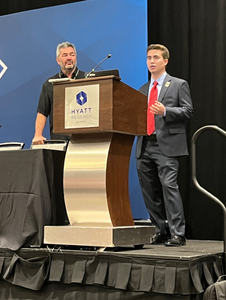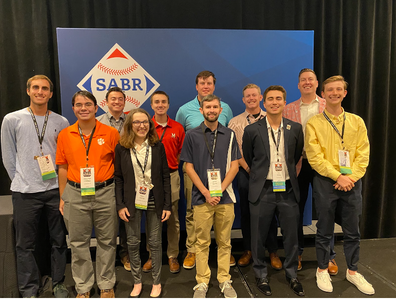The Science of Sabermetrics
By Gabrielle Drillis
This summer, CGS Master Lecturer of Natural Sciences & Mathematics Leonard “Andy” Andres, and student E.J Wong (’21, CDS ‘23) showcased months of collaborative research at the Society for American Baseball Research’s annual conference in Baltimore, MD. Their project was driven by the desire to determine if there is a way to accurately predict a team’s success in the playoffs and the variety of factors that play into it. A crowd of over 400 people listened to the pair present their research successfully, earning Wong 1 of 10 Yoseloff Scholarships awarded at the conference. This scholarship aims to support students interested in the field of baseball analytics, introduce them to fellow researchers, and cover the cost of attending the next annual SABR Conference.
Andres and Wong were introduced to each other through the help of other CGS faculty. With Andres’ extensive knowledge of baseball analytics and Wong’s fascination with the sport, the two made a perfect pair. After some time, Andres encouraged Wong to take his interest to the next level through the creation of a research abstract. Once it was approved, the two began their mission to build a set of characteristics that can help predict the success of a team in the playoffs. The field of sabermetrics has a diverse set of tools that can be used to properly construct data sets, including physics, biology, and mathematics to analyze different factors of players, teams, and the game overall.
We spoke to Andres and Wong about their partnership, the research they’ve conducted, and their personal hopes for the future of sabermetrics.
Q: Tell me a bit about yourselves and how you each came to form such a passion for baseball and sabermetrics.

Wong: I am a current senior here at Boston University and am a Data Science major with a Statistics minor. I currently play for the BU Club Baseball Team and I truly enjoy sabermetrics as my outside research and work. I was introduced at a very young age to baseball data, so as a person who has been playing baseball practically since I was born, I’ve been learning all of these statistics amongst other things. I’m fortunate that I’m more of an analytical-minded person so I am able to understand and enjoy these things and find passion and knowledge for this.
One of the things that truly helped me become more analytical-minded was one of my instructors in high school. He had a hitting simulator; it tells you various measurements that help you understand what’s going on with the ball and it really helped me open my horizons. There is a huge field devoted to the study of this and there are people who are paid to study these statistics in the MLB.
Andres: My interest started with being a fan of baseball since I was five years old. I was a player as a young person. Then, in college through my forties I was a softball player, which is a different game from baseball, but someone eventually asked me to play baseball again and now I play, thankfully, with people my age.
When I was playing softball, two other good friends of mine shared an interest in Bill James and his research so we would all read and share books. Eventually we agreed this should be a college course, so we designed a course around the ideas of baseball analytics and it was the first one. The class was originally offered at Tufts. In 2014, BU said yes, so we taught an online class on this topic. It is still available in the EdX online platform. So, since 2003 I have been doing more and more baseball data science. It really started because I began teaching that class.
Q: What led you two to one another? How did you meet?
Wong: I was fortunate enough to meet Dr. Andres my sophomore year through the recommendation of another CGS professor, Dr. Susan Lee, who is now retired. Through Dr. Andres I began learning about baseball statistics and sabermetrics and how to start the research process.
Q: Could you explain in simple terms what sabermetrics is and what your project focused on specifically?
Wong: The study of sabermetrics is baseball specific. We use statistics of hitting, pitching, and fielding to draw conclusions and make player evaluations. It allows us to have empirical evidence of reasoning. We can add in fields like physics and biology to sabermetrics to build a stronger and better value of performance not just on the field, but other aspects that help make baseball players succeed to their maximum likelihood.
As a Dodgers fan, they’ve had some bad luck in the playoffs. They made the playoffs 10 seasons in a row but only managed to win the World Series one of those times and as a Dodgers fan that is quite frustrating. I’ve always talked to Dr. Andres about this and that but one of the things we kept rolling on was the question of how does a team succeed in the playoffs? And I think that’s a very important thing that got the ball rolling. Eventually Dr. Andres recommended I submit an abstract and possibly start our own research on this idea. Before we knew it we decided to go about it and ended up submitting an abstract about how to measure success in the playoffs.
Andres: The study we did was on all teams; we looked at all teams that made it to the playoffs and tried to distinguish in that group what characteristics made them succeed in the playoffs.
Q: What was it like to present at such a large and professional conference, especially for you, EJ?
Wong: I haven’t done too much public speaking in my life so it was something different. Dr. Andres was a great help for me because he always talks in front of students and lectures in front of big crowds. He was able to guide me through. It was a bit of a shell shock with 400 eyes looking up at you, you know? It was really fun and there was a big positive perception. People enjoyed listening and hearing about things that they have probably thought of a bit but haven’t had too much concrete research. People always want to hear something that matters, and that’s the biggest thing in baseball: how does a team win the playoffs?
Andres: I think our experience at the conference led to a bunch of new questions and we will try to think about that. We each have the right bandwidth to help answer more questions and I know E.J is very passionate about this research.

Q: Have you been working on any new baseball or sabermetrics research since the conference, either individually or collaboratively?
Wong: After our presentation we had a pretty long Q&A session afterwards and outside the room I had close to 70 people talk to me, so we have been talking a little bit more and we want to expand this work. There are a lot more topics and variables that we had not originally thought of and we hope to publish this and pitch it to outside audiences.
Andres: I think all along, the way I treat E.J and any other student interested in research of baseball analytics, is I really try to let them drive the questions. I view my role as a navigator of the questions, moving here and there and trying to steer it the right way, but I always look for the students to be the engine.
In terms of what we do next, E.J is as knowledgeable in this as I am, if not more knowledgeable, so I will be glad to keep steering the direction of where we head. I do have to say, my first thought on the new rules for next year was that the pitch clock was a terrible idea! Now, I’ve done a complete 180º after seeing it in action and think it’s a great idea. I can’t wait for it to come to the major leagues.
Q: Do you plan to incorporate sabermetrics into your post graduate career, EJ?
Wong: The ultimate goal for me is to work in the MLB front office in the analytics department. Whether it’s as a data scientist, data analyst, or other quantitative work, I am willing to go into it to get that job because this is what I love. This is my passion and what I desire. I want to be a lifelong learner and learn as much as I can, so I want to be in the MLB front office, no matter what position it may be.
Q: What are your favorite baseball teams and players?
Wong: As I said before, I am a huge Dodgers fan. My favorite baseball player has been my favorite for a long time: Clayton Kershaw. I have always liked him. He has this disgusting curveball and as a pitcher, you know, I try to figure out how to get Kershaw’s curveball.
Andres: I actually really root for the Dodgers often. Three of my former students work for the Dodgers. I tend to root for teams that have hired my students, so I root for the Dodgers and a bunch of other teams. Believe it or not, my first team as a young boy was the White Sox because my grandfather was a White Sox fan. Then it was the Mets because I lived in the New York metro area. Then I came to college in New England and went to a bunch of Red Sox games when it was easy to get in, so I was at Fenway Park a lot and it made me a Red Sox fan. Even if the Red Sox played the Dodgers I would still vote for the Red Sox. Many teams have been smart enough to hire my students, so I am a fan of many teams!
I’d say today my favorite player is probably Shohei Ohtani. I admire the things he does on a baseball field; it’s extraordinary. But I have changed my favorite player throughout the years. When I was a fan of the Mets, my favorite player was Tommy Agee. Recently a big name that I loved watching play was David Ortiz. He has this ability of covering the strike zone and hitting all different pitches, different locations, different velocities. It is so hard to get an inning by David Ortiz and he just hit the ball hard. Watching Ortiz was a pleasure. I could keep going, but it’s fun to watch these extraordinary human beings perform at the highest levels of this sport.
